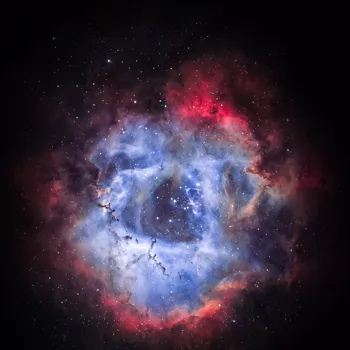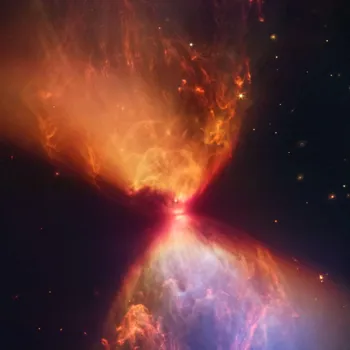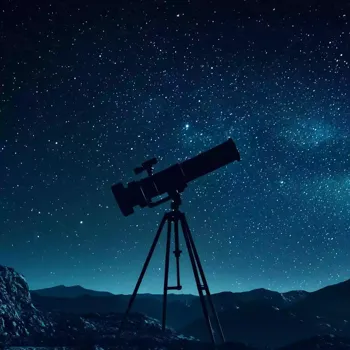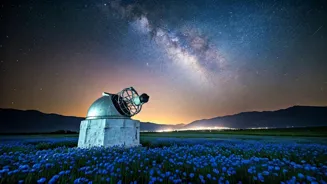Unveiling Secrets of Stars: How Spectroscopy Decodes Celestial Mysteries. Dive into the cosmic detective's toolkit!
Imagine gazing at the night sky, speckled with countless stars. How do scientists, sitting
here on Earth, unravel the secrets of these celestial bodies, light-years away? The answer lies in a powerful technique called spectroscopy.
It's like a cosmic detective's toolkit, allowing astronomers to analyze the light emitted by stars and deduce their composition, temperature, and even their movement.
Spectroscopy: Analyzing light-matter interaction reveals star composition
Spectroscopy is essentially the study of how light interacts with matter. When starlight passes through a prism or a similar device called a spectroscope, it gets separated into its constituent colours, creating a spectrum.

This spectrum isn't just a pretty rainbow; it's a treasure trove of information. Each element emits or absorbs light at specific wavelengths, creating unique patterns of bright or dark lines within the spectrum.
These patterns are like fingerprints, allowing scientists to identify the elements present in a star's atmosphere. By analyzing the intensity and position of these spectral lines, scientists can determine the abundance of each element, giving them a glimpse into the star's chemical makeup.
Spectroscopy reveals element details in star's spectrum
The beauty of spectroscopy lies in its ability to reveal so much from so far away. Different elements leave distinct 'fingerprints' on the spectrum of light. For instance, hydrogen, the most abundant element in the universe, has a specific pattern of lines.

Similarly, elements like helium, oxygen, and iron also have their own unique spectral signatures. By carefully examining the spectrum of a star, astronomers can identify which elements are present in its atmosphere and in what quantities.
This tells them about the star's age, origin, and the processes occurring within it.
Star temperature dictates color, light emitted; spectroscopy classifies stars by type
The temperature of a star plays a crucial role in determining its color and the type of light it emits. Hotter stars tend to emit more blue light, while cooler stars emit more red light.

Spectroscopy allows astronomers to measure the distribution of light across the spectrum and determine the star's surface temperature with remarkable accuracy.
By analyzing the shape of the spectrum, scientists can classify stars into different spectral types, such as O, B, A, F, G, K, and M, each corresponding to a specific temperature range. Our Sun, for example, is a G-type star with a surface temperature of around 5,500 degrees Celsius.
Spectroscopy reveals star movement via redshift and blueshift
Interestingly, spectroscopy can also reveal whether a star is moving towards or away from us. This is based on the Doppler effect, the same phenomenon that causes the pitch of an ambulance siren to change as it approaches and recedes.
When a star is moving towards us, its light waves are compressed, causing a blueshift, meaning the spectral lines are shifted towards the blue end of the spectrum.
Conversely, when a star is moving away, its light waves are stretched, causing a redshift, with the spectral lines shifted towards the red end. By measuring the amount of redshift or blueshift, astronomers can determine the star's radial velocity, its speed along our line of sight.
Scientists face challenges in studying stars due to Earth's atmosphere. Indian researchers contribute to this field
There are some limitations and challenges faced by the scientists, such as the interference of Earth's atmosphere. The atmosphere can absorb and scatter starlight, making it difficult to obtain clear and accurate spectra.

To overcome this, astronomers often use telescopes located at high altitudes or in space, where the atmosphere is thinner. Furthermore, the faintness of distant stars can also pose a challenge, requiring long exposure times and sensitive detectors to collect enough light for analysis.
Indian scientists and researchers are progressively exploring the potential and have been contributing the study and analysis of distant stars.
Spectroscopy reveals galaxy composition, evolution, exoplanets
Spectroscopy is not just limited to studying individual stars; it can also be used to analyze the light from entire galaxies. By examining the spectra of galaxies, astronomers can determine their composition, distance, and even their rate of rotation.
This information helps us understand the formation and evolution of galaxies and the distribution of matter in the universe. Moreover, spectroscopy plays a vital role in the search for exoplanets, planets orbiting stars other than our Sun.
By analyzing the subtle changes in a star's spectrum as a planet passes in front of it, astronomers can detect the presence of exoplanets and even estimate their size and composition.











